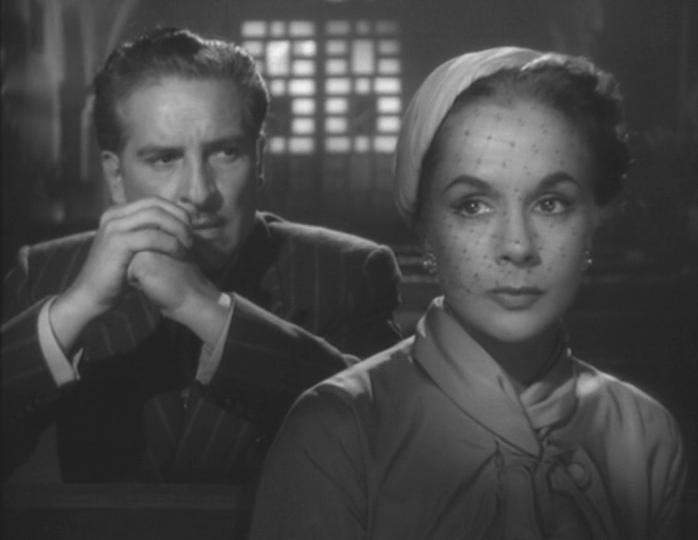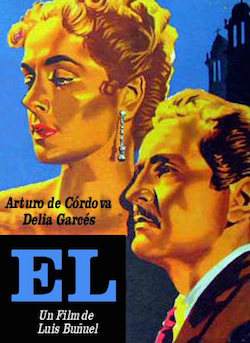
El (Mexico, 1953) 92 min B&W DIR: Luis Buñuel. PROD: Óscar Dancigers. SCR: Luis Buñuel, Luis Alcoriza; based on the novel by Mercedes Pinto. MUSIC: Luis Hernández Bretón. DOP: Gabriel Figueroa. CAST: Arturo de Córdova, Delia Garcés. (Columbia Pictures)

In this arresting tale, Don Francisco (Arturo de Córdova), a 40-ish aristocrat, becomes obsessed with a woman named Gloria (Delia Garcés) at first sight… her elegant feet being bathed in church! El has been lauded for its complex study of the man’s near-insane bouts of jealousy (quickly followed by his overwhelming repentance). The man is clearly a psychopath: charming to many (even Gloria’s mother disbelieves her account of one of his more violent outbursts), but underneath he is a possessive man-child, with the behaviour of a stalker. In an early scene, Francisco meets Gloria again in a church, and she leaves to get in a car driven by her fiancé. This long shot pans over to see Francisco get in his car to follow her. Subsequently, he ruins her impending engagement, and somehow convinces this woman to become his bride.
The honeymoon scene on a train is a minimalist revue of Sturges’ The Lady Eve, without the comedy. First, on the conjugal bed, he is revealed as the jealous fool he is, asking degrading questions of new wife, then retiring to another bed in the car. Fade out. Fade in on the same scene: the snivelling man begs for forgiveness, and the two embrace. Cut to an underexposed exterior shot of the phallic train stabbing through the darkness. The bride is being carried over a strange threshold.
Francisco’s jealousy begets even more outrageous acts. He punches out a hotel patron whom he accuses of peeping on his wife, and then puts a needle through the keyhole! In one shocking act, he ties up Gloria, she luckily escapes his unnecessary wrath. Similarly, his pleading for forgiveness (excessive acts of personal penance) after each atrocious act becomes even more pathetic. In the film’s famous finale, Gloria and her new husband visit Francisco at a monastery, since he has converted to the cloth to cap his jealous rages (an interesting metaphorical castration). However in the final shot, Francisco walks to the background… in zig-zag pattern, suggesting his continued insanity beneath the suppression.
Of course, El‘s opening is equally perverse- as his infatuation with Gloria began at a church function. By the same token, this introductory image of Gloria’s feet being bathed signifies a purity that he goes to sadistic lengths to “preserve”. At one point, he even berates Gloria for going to confession… for she has divulged to the church their private moments! In the climactic scene, he strangles a priest, whom he thinks is making fun of him (in a gripping scene with expert use of jump cuts to juxtapose the real, placid images with Francisco’s mad visions).
El (released in North America with the fuller title, El: This Strange Passion) has been re-evaluated as a vital piece of Buñuel’s filmography. I first caught the film on Jay Scott’s TVO program, Film International in the late 1980s. As of this writing, I don’t believe it’s commercially available on disk, although it appears on YouTube here and there.
